
by Deep Green Resistance News Service | Apr 29, 2017 | Education
by Max Wilbert / Deep Green Resistance Great Basin
As a kid, I pictured Nevada as a wasteland of sand and cacti. Today, I know better.
For the past five years, I’ve been packing up my truck every spring and taking a long day to drive to eastern Nevada to bask in the glory of one of the least densely-populated areas of the United States.
The broad valleys never fail to stun me, but most amazing are the mountains, limestone peaks arcing into the sky. Springs and creeks flowing from the hills support rich riparian zones and bring in birds and other wildlife from miles around. Antelope, deer, elk, and wild horses cross the valleys or stick to forested patches. This region is lush, biodiverse, and beautiful.
It’s also under threat. Across eastern Nevada, the Southern Nevada Water Authority seeks to build dozens of massive groundwater wells and pump almost every drop of water south to feed Las Vegas developments. The project has been a battle between locals and developers from Vegas for decades, and still drags on.
Another major threat is felling pinyon pine and juniper forests across not just this region, but the entire intermountain west. Ranchers have been doing this for decades to remove pesky trees getting in the way of their grass—and more importantly, their profit. As overgrazing continues to desertify Nevada—it’ll look like Iraq in another 100 years—removing trees allows ranchers to maintain the illusion that overstocking can continue indefinitely.
Countless people, including myself, are mobilizing to fight like hell for this land, this water, and these forests. We aim to stop these destructive projects by exposing their true nature and—if necessary—standing in their way.
There is a lot more to these stories, but I don’t have time to share it all here. Instead, I’d like to invite you to join myself and other community members, indigenous people, activists, ecologists, photographers, and families for the fifth annual Sacred Water, Sacred Forests Camp.
The camp takes place over Memorial Day weekend, May 27 to 29, near the town of Ely and Great Basin National Park. If you’re interested in attending, you can RSVP on the Facebook event page or by emailing greatbasin@deepgreenresistance.org.
I hope to be able to introduce you to this important, imperiled area in a few weeks.
—
Max Wilbert is a community organizer based in western Oregon who considers Nevada a second home.
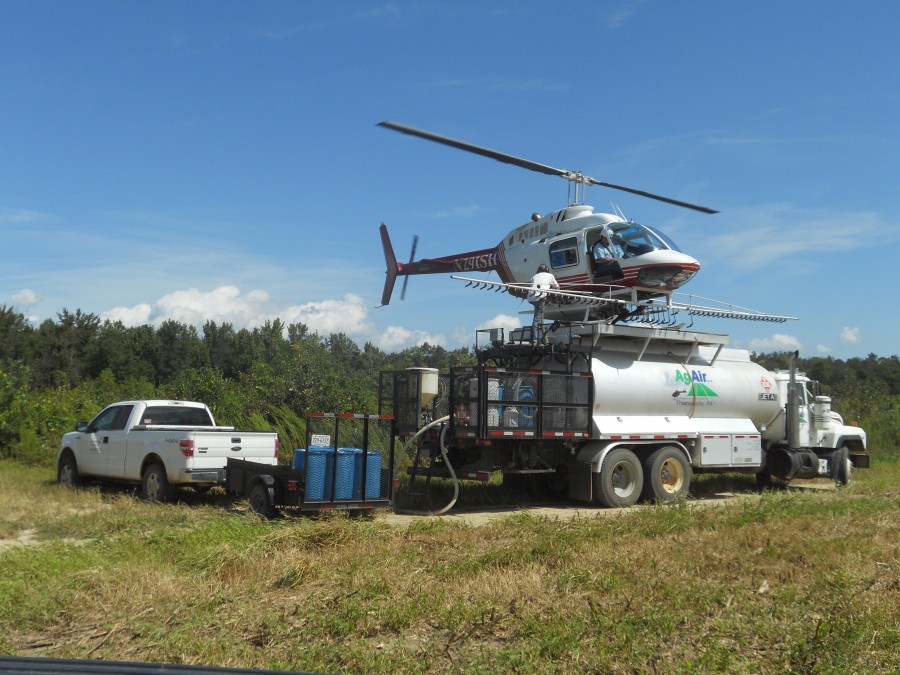
by Deep Green Resistance News Service | May 7, 2016 | Biodiversity & Habitat Destruction, Toxification
This article originally appeared on Counterpunch
By Katie Fite / Wildlands Defense
BLM is escalating herbicide use on public lands in the wake of the September 2015 Sage-grouse Plan Amendments and the U.S. Fish and Wildlife Service’s Not Warranted Finding for ESA listing. A primary agency excuse for forsaking sage-grouse ESA protection is the pipe dream that new habitat will be created through radical deforestation, and that fuelbreaks will stop fires. The Finding lays it out:
Cumulatively, the FIAT assessments of the five priority areas identify more than 16,000 km (10,000 mi) of potential linear fuel treatments, approximately 2.99 million ha (7.4 million ac) of potential conifer treatments, more than 2 million ha (5 million ac) of potential invasive plant treatments, and more than 7.7 million ha (19 million ac) of post-fire rehabilitation (i.e., should a fire occur, the post-fire rehabilitation identifies which areas BLM would prioritize for management) within the Great Basin region…
The deforestation acreage is larger than Vermont. Native pinyon and juniper trees are treated as weeds, rather than a forest community vital for biodiversity and buffering climate change effects. Real weeds will have a field day in the wake of the bulldozers, bull hogs, masticators, chain saws, mowers, roller-choppers, brush beaters and “prescribed” fire unleashed for subduing woody vegetation. Lands will be doused with herbicides to try to keep cheatgrass, rapidly advancing medusahead, and others from thriving in the wasted, bared soils and hotter, drier, grazed sites. The fuelbreaks will raze sage and trees across a distance greater than that between Patagonia and the North Pole. These cleared zones will parallel many roads on public lands, further fragmenting wildlife habitats and providing fertile grounds for flammable annual grass in the chronically grazed arid landscape, and for human-caused catalytic converter, target shooting and other fire ignitions.
BLM is further reverting to a 1960s worldview of farming-style manipulation of wild lands, mainlining chemicals in support of its treatment habit. This distracts attention from the fact that the new BLM Sage-grouse Plan Amendments allow livestock grazing and many other threats to the bird to continue with little real change, despite a torrent of litigation claiming otherwise. In support of the folly, NRCS and BLM have concocted elaborate models deeming native forest and sage expanses unhealthy or “at risk.” After clearing, the land may be seeded, often with a mix of exotic forage grass and “cultivars,” not the local native plant ecotypes, but plants bred to be big and tough and a livestock forage boon. Places purged of woody plants will be embedded in a landscape “compartmentalized” (BLM’s term) by fuelbreaks.
Livestock grazing is a primary cause of weed infestation and dominance across public lands. But BLM refuses to deal with livestock as a cause of weeds. PEER very recently filed a complaint with CEQ and rancher sycophant Interior Secretary “what’s good for the bird is good for the herd” Sally Jewell over BLM’s denial of the climate effects of cattle and sheep grazing.
That’s only part of it. BLM is a weed denier of the worst sort, and willfully blind to the adverse climate effects of its land clearing. Instead of addressing cattle causes of weeds, BLM’s time honored method is to spray and walk away, leaving livestock free to graze and trample sprayed land in short order, churning soils and copiously defecating, ensuring a fresh batch of weeds takes hold.
2007 Weed EIS and PER Set the Stage
In 2007, BLM completed a Westwide 17 State Weed EIS and risk assessments for expanded herbicide use tripling sprayed acres, along with a Programmatic Environmental Report PER bedfellow laying out burning, chaining, mastication, bull hogging, mowing, brush beating, harrowing, “biological thinning” (dustbowl style grazing) and other severe weed-causing disturbance assaults on native vegetation communities. Environmentalists implored the BLM to address weed causes, employ passive restoration and minimize spraying. BLM ignored this, saying weed causes were dealt with in “allocations” of Land Use Plans. The many Plans issued since then do not address causes of weeds in divvying up “forage” and other allocations, like this and this. Risk assessments based on minimal info, predictably found the chemicals were safe for public land. The PER’s ecological impacts were never analyzed. The fore-shadowed radical treatment disturbance, now funded by hundreds of millions of dollars of sage-grouse and fuels funds, is laying waste to the West. BLM’s project rationales are a constantly moving target.
The Oust Debacle
As BLM was preparing the Weed EIS, it became embroiled in litigation with southern Idaho farmers over a crop catastrophe. BLM had ballyhooed DuPont’s Oust herbicide as a panacea for cheatgrass. Prominent range staff that had long pushed exotic forage plants as desirable on “rangelands” worked closely with DuPont to fine-tune the chemical.
“Oust is the best tool we’ve ever had, yes sir,” says Scott Anderson, a supervisor in the BLM’s Shoshone, Idaho, office. “There’s nothing like it.”… “In the mid-1990s, BLM officials began using it experimentally against cheatgrass, which the agency had been fighting a losing battle to control. They discovered that when sprayed immediately after a fire, Oust was nearly 100% effective in suppressing the growth of cheatgrass for at least a year. “That gave us an opportunity to come in and reseed the sagebrush and other desirable vegetation,” explains Mike Pellant, a BLM rangeland ecologist in Boise.
Oust kills plants by preventing roots from taking in water and nutrients from the soil.
It did this splendidly when the wind blew herbicide-infested soil onto crop fields and poisoned the earth. After the farmers finally figured out what had happened, BLM declared an Oust moratorium. Prolonged litigation ensued, with over 66 days of testimony in federal court. A jury trial and verdict found BLM bore 40% responsible, and Dupont 60%. Damages of 17 million dollars were awarded to the farmers. But the District Court ruling was appealed, and reversed by the Ninth Circuit in 2011. Courthouse News described the long ago initial filing “a day late and 17 million dollars short.”
“Idaho farmers filed their complaint a day too late to collect damages from the government after their crops were caught in the crossfire of a federal agency’s herbicidal battle against non-native grass, the 9th Circuit ruled Thursday … The farmers’ claims against the Bureau of Land Management (BLM) are “forever barred.”
Oust affected so much ag land that damage was detected. Most of the spraying takes place in remoter wild places where drift effects could escape detection.
Meanwhile, BLM kept on spraying, purposefully blind to weed causes. The 2007 Weed EIS blessed Plateau (Imazapic) as the new cheat panacea. Mowed and roller-chopped sage, prescribed burned forests and sage, and wildfire areas were doused with Plateau. It was applied over untold 100,000s of acres following fires. But there is still a hitch. Similar to Oust, Plateau kills “desirable” seedlings. So at the same time BLM has been spending tens of millions of dollars on seeding burned lands ostensibly for sage-grouse, it applied a potent lingering seedling killer. A scientist letter responding to BLM’s unprecedented 67 million dollar rehab boondoggle for the Soda Wildfire pointed out:
First, spraying a pre-emergent herbicide (imazapic/Plateau) may not have much effect on cheatgrass in 2015 because it germinated prior to application. Second, and much more importantly, imazapic will kill any seedling forbs that emerge from the seed bank. This will decrease abundance and diversity of forbs which are necessary for sage grouse…
Plateau also kills sage seedlings and the native seeds in the soil seedbank. Without sage, the sage-grouse, pygmy rabbits and other wildlife are doomed.
Oregon: A Special Case, and Sacrificing the Eastside
Oregon citizens and activists have often been alert, vocal and litigious in opposition to public and private lands herbicide campaigns that take place in the big dollar timber country on the west side of the Cascades. So BLM deals with ecosystems and people there a bit more lightly. In 1984, an injunction in Northwest Coalition for Alternatives to Pesticides et al. v. Block prohibited herbicide use by BLM and the Forest Service in Oregon. BLM prepared a new EIS for four herbicides in 1987, and the injunction was modified, allowing 2,4-D, dicamba, glyphosate, and picloram. In 2010 a new EIS expanded herbicides. It has fewer protections for lands, waters, fish, frogs, wildlife and people on the east side of the Cascades. BLM added 10 more herbicides west of the Cascades, but did not allow aerial spraying, vs. 13 more herbicides east of the Cascades and allowed aerial spraying.
In synch with its 2007 EIS, BLM went far beyond treating “noxious” weeds in Oregon. “Management objectives” ballooned: the control of all invasive plants; the control of plants as necessary to control pests and diseases …; the control of vegetation to meet safety and maintenance objectives …; and, the treatment of vegetation to achieve specific habitat goals for Federally Listed and other Special Status species …
East of the Cascades, 2,4-D, Dicamba, Fluroidone, Imazapic, Imazapir, Picloram could be sprayed aerially (note this is fewer chemicals than inflicted on the rest of the states aerially in the 2007 EIS). There is so-called “restricted” use of Chlorsulfuron, glyphosate, hexaninone, metsulfuron metyl, tebuthiuron “only where no other means available” … “where practical, limit glyphosate and hexaninone to spot applications.” Weasel word language is pervasive, providing leeway to wiggle out of promised protections. If livestock might eat the plants, BLM is to apply “at the typical rather than the maximum rate,” but no word on what to do about native ruminants “don’t apply some chemicals where wild horses are present, or herd them out of the area.” There is minimal protection for recreation – a campground might be fleetingly signed. Protections recommended for reptiles and amphibians were not adopted, even provisions leaving bits of untreated habitat as refugia were scuttled. BLM is increasingly outsources spraying, through agreements with Counties and “cooperators.” Protections that appear to have survived could readily fall by the wayside in practice.
The Spray and Walk Away Path Forward
Now BLM has just released a Final EIS adding three more bizarrely named chemicals (rimsulfuron, fluroxypyr, aminopyralid) for use across the West in its War on cheatgrass, medusahead, prickly pear (which with along with the saguaro are a keystone desert species), pigweed and others.
BLM claims these chemicals are safer for the environment and human health than those already in use. Safe, like aminopyralid that can be spread through manure? Or safe like post-emergence burndown rimsulfuron that is touted as great for mixing with others of its ilk, and for which even BLM’s assessment admits a drift risk for non-target vegetation? Just like Oust and Plateau, rimsulfuron kills seedlings of the very plants that wildlife must have to survive. There are only a few days left to weigh in on this latest EIS (blm_wo_vegeis@blm.gov). Meanwhile, step-down EA analyses expanding aerial spraying and broadening herbicide use are proliferating at the BLM District level.
BLM insisted their were minimal downsides to the banished Oust, the fallen from favor Plateau and the rest of the toxic lot, including woody plant killers like Tebuthiuron, which caused a profusion of cheatgrass in Nevada sage purging reminiscent of the 1960s. The current chemicals and all their associated carriers, adjuvants, breakdown products and other associated toxins, including unknowns from mixes of multiple active chemical ingredients that BLM allows, had been deemed safe in the 2007 EIS. Now that BLM has had a revelation that they are less safe, it is not dropping a single chemical.
What will the 7 million acres of new treatments, 10,000 linear miles of permanent bleak fuelbreaks, and rehabbing of failed fire rehabs (often using many of the same old techniques) do to the land? And how much spraying will accompany forest clearing for porkbarrel biomass? Beyond the butchered landscape, desertification and destroyed habitat, it may often be impossible for people to avoid unwanted exposure to herbicides on visits to public lands. Access roads will be bordered by FIAT-ordained fuelbreaks for long stretches. Cleared of “brush” and seeded with exotic forage grass, they will be favored cattle loafing areas. Aerial herbicide use in wild land settings with fickle weather ensures drift onto the road and dust, onto camping sites, killing non-target vegetation, polluting water in springs and streams, and contaminating sage-grouse, antelope and pygmy rabbit foods. New irreversible native species habitat loss and expanded habitat fragmentation will take place. Public lands will bear an even greater resemblance to an intensive cattle ranch operation under this desolate paradigm. How long will agency grazing climate and weed denial go on? Or denial of the climate consequences of deforestation right here at home? But look everybody, over there, a bright shiny new million dollar treatment saving sage-grouse.
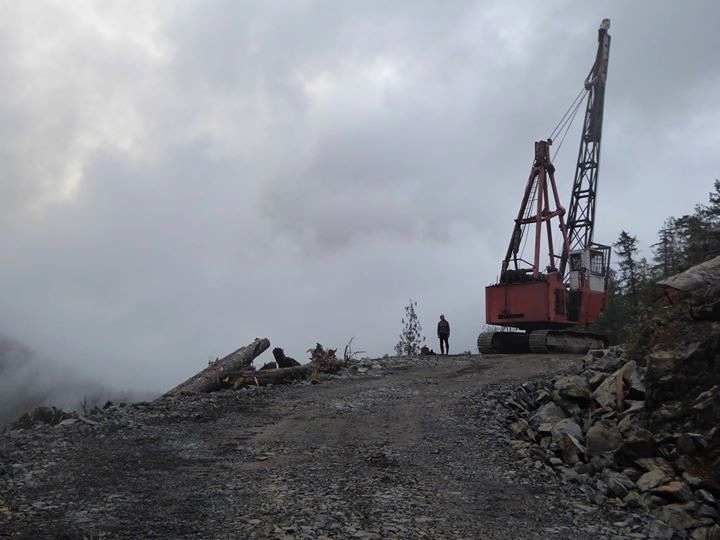
by Deep Green Resistance News Service | Apr 27, 2016 | Biodiversity & Habitat Destruction, Strategy & Analysis
By Zoe Blunt / WildCoast.ca
“I’m in love. With salmon, with trees outside my window, with baby lampreys living in sandy streambottoms, with slender salamanders crawling through the duff. And if you love, you act to defend your beloved.” — Derrick Jensen
Pacific Coast people have always defended the places we love. Most of British Columbia is unceded indigenous land; native peoples have never abandoned, sold, or traded their land away. Many fought fiercely against the power of the British Empire. Cannonballs are sometimes still found embedded in centuries-old trees along the shore – leftovers from the gunboats that tried to suppress indigenous uprisings in the late 1800s.
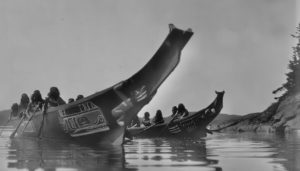
Nuu-chah-nulth war canoes (Edward Curtis, BC Historical Society)
A century later, descendants of the settlers have joined forces to battle corporate raiders. In the 1980s and 1990s, a groundswell of eco-organizing brought thousands of people together to stop clearcut logging in the cathedral forests of Vancouver Island’s Pacific coast, where timber companies were busy converting ten-thousand-year-old ecosystems into barren stumpfields and pulp for paper.
During those years, police arrested hundreds in Clayoquot Sound and the Walbran Valley at mass civil disobedience protests. Young and old alike sat in the middle of the logging roads and linked arms. The resistance went far beyond the peaceful and symbolic: unknown individuals spiked thousands of trees to make the timber dangerous to sawmills. Shadowy figures burned logging bridges and vandalized equipment. The skirmishes went on for over a decade.
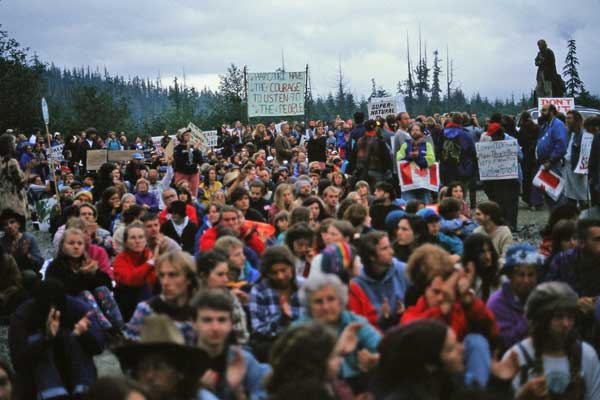
Clayoquot Sound, 1993
We won a few battles. Several coastal valleys are protected as parks. But many of them have been logged. And now the logging companies are coming back for the valleys that remain unprotected.
One of the worst corporate offenders is Teal Jones, the company currently bulldozing the majestic Walbran Valley, two hours west of Victoria, BC. They are laying waste to a vibrant rainforest for short-term profit, without the consent of the Pacheedaht First Nation, the Qwa-ba-diwa people, or anyone else outside of government and industry. Teal Jones does not even own the land; it was taken from indigenous people in the name of the BC government sixty years ago.
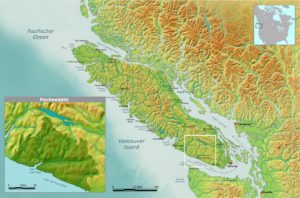
Pacheedaht territory, Vancouver Island BC
This year, the elected leadership of the Pacheedaht First Nation threw its support behind building a longhouse in the contested valley, on the land that has sustained them for countless generations. At the same time, locals are pushing back against the logging by occupying roads and logging sites. This in spite of the company’s court order telling police to arrest anyone who blocks their work. Forest defenders are regrouping, but the destruction continues.
Women for the Walbran and Forest Action Network are ramping up to break the deadlock. We’re hosting direct action trainings to share skills and develop strategies for defending ecosystems. The agenda includes tactics like non-violent civil disobedience, occupying tree-tops, and backcountry stealth. We’ll have info on legal rights, indigenous solidarity, and more.

Tree-sit occupation, Langford BC. (Photo: Ingmar Lee)
Our adversary, Teal Jones, is a relatively small company. Its owners are relying on the police to protect their “right” to strip public forests on Pacheedaht traditional territory. Profit margins are slim, and lawyers are expensive. The forest defenders are poor, but we have community support and a wide array of strategies for beating Teal Jones at its own game. Every tool in the box: we can launch a mass civil disobedience campaign, carry out hit-and-run raids on costly machines, coordinate a knockout legal strategy, or deliver the tried-and-true “death by a thousand cuts” with a combination of tactics.
However it plays out, Teal Jones is on borrowed time in the Walbran. But that’s cold comfort when the machines are mowing down thousand-year-old forests like grass.
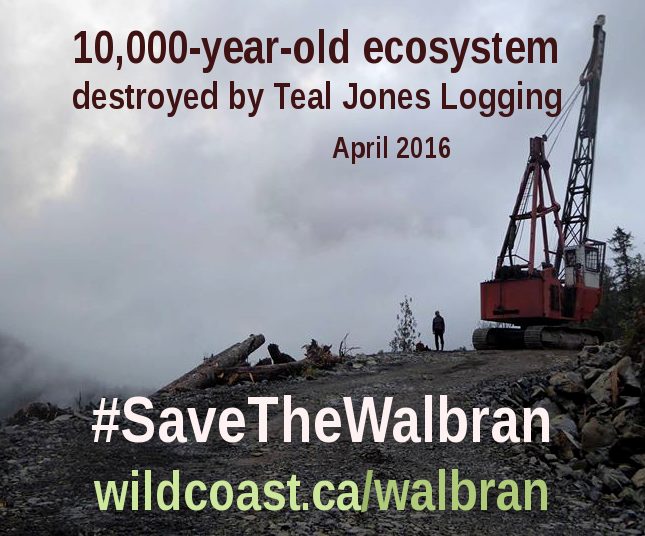
Photo: Walbran Central
The forest defenders do have certain advantages. On the practical side, we’re investing in the gear and training that will provide the leverage to win. We have a legal defense fund that’s both a war chest for litigation and a safety net for those who risk their freedom on the front lines. But our best defense is the thousands of people who love this land like life itself. Many live nearby and visit every chance they get, others came once and fell in love, and untold numbers have yet to see the Walbran’s wildlife firsthand, but they hold it in their hearts.
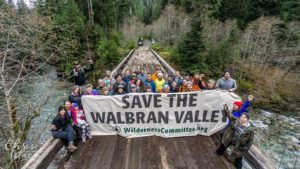
Photo: Walbran Central
Those who love the land are a community. We are the organizers, sponsors, and volunteers who drive this movement forward. Everyone who shares these values can be a part of it; no contribution is too small. We’re going all-out to defend the forests, rivers, bears, cougars, otters, and eagles of the Walbran Valley. They sustain us and we give back by fighting to protect them.

Walbran River, the heart of the Walbran Valley, spring 2016. (Photo: Walbran Central)
Remember: Forest Defenders Are Heroes!
by DGR News Service | Mar 15, 2016 | Listening to the Land
Featured Image: Abandoned mill near Sorrento, Italy, by Jason Wallace
Derrick Jensen / Deep Green Resistance
In the time after, the buffalo come home. At first only a few, shaking snow off their shoulders as they pass from mountain to plain. Big bulls sweep away snowpack from the soft grass beneath; big cows attend to and protect their young. The young themselves delight, like the young everywhere, in the newness of everything they see, smell, taste, touch, and feel.
Wolves follow the buffalo, as do mallards, gadwalls, blue-winged teal, northern shovelers, northern pintails, redheads, canvasbacks, and tundra swans. Prairie dogs come home, bringing with them the rain, and bringing with them ferrets, foxes, hawks, eagles, snakes, and badgers. With all of these come meadowlarks and red-winged blackbirds. With all of these come the tall and short grasses. With these come the prairies.
In the time after, the salmon come home, swimming over broken dams to forests who have never forgotten the feeling of millions of fish turning their rivers black and roiling, filling the rivers so full that sunlight does not reach the bottom of even shallow streams. In the time after, the forests remember a feeling they’ve never forgotten, of embracing these fish that are as much a part of these forests as are cedars and spruce and bobcats and bears.
In the time after, the beavers come home, bringing with them caddisflies and dragonflies, bringing with them ponds and pools and wetlands, bringing home frogs, newts, and fish. Beavers build and build, and restore and restore, working hard to unmake the damage that was done, and to remake forests and rivers and streams and marshes into who they once were, into who they need to be, into who they will be again..
In the time after, plants save the world.
In the time after, the oceans are filled with fish, with forests of kelp and communities of coral. In the time after, the air is full with the steamy breath of whales, and the shores are laden with the hard shells and patient, ageless eyes of sea turtles. Seals haul out on sea ice, and polar bears hunt them.
In the time after, buffalo bring back prairies by being buffalo, and prairies bring back buffalo by being prairies. Salmon bring back forests by being salmon, and forests bring back salmon by being forests. Cell by cell, leaf by leaf, limb by limb, prairie and forest and marsh and ocean; they bring the carbon home, burying it in the ground, holding it in their bodies. They do what they have done before and what they will do again.
The time after is a time of magic. Not the magic of parlor tricks, not the magic of smoke and mirrors, distractions that point one’s attention away from the real action. No, this magic is the real action. This magic is the embodied intelligence of the world and its members. This magic is the rough skin of sharks without which they would not swim so fast, so powerfully. This magic is the long tongues of butterflies and the flowers who welcome them. This magic is the brilliance of fruits and berries who grow to be eaten by those who then distribute their seeds along with the nutrients necessary for new growth. This magic is the work of fungi who join trees and mammals and bacteria to create a forest. This magic is the billions of beings in a handful of soil. This magic is the billions of beings who live inside you, who make it possible for you to live.
In the time before, the world was resilient, beautiful, and strong. It happened through the magic of blood flowing through capillaries, and the magic of tiny seeds turning into giant redwoods, and the magic of long relationships between rivers and mountains, and the magic of complex dances between all members of natural communities. It took life and death, and the gifts of the dead, forfeited to the living, to make the world strong.
In the time after, this is understood.
In the time after, there is sorrow for those who did not make it: passenger pigeons, great auks, dodos, striped rocksnails, Charles Island tortoises, Steller’s sea cows, Darling Downs hopping mice, Guam flying foxes, Saudi gazelle, sea mink, Caspian tigers, quaggas, laughing owls, St. Helena olives, Cape Verde giant skinks, silver trout, Galapagos amaranths.
But in those humans and non-humans who survive, there is another feeling, emerging from below and beyond and around and through this sorrow. In the time after, those still alive begin to feel something almost none have felt before, something that everyone felt long, long ago. What those who come in the time after feel is a sense of realistic optimism, a sense that things will turn out all right, a sense that life, which so desperately wants to continue, will endure, will thrive.
We, living now, in the time before, have choices. We can remember what it is to be animals on this planet and remember and understand what it is to live and die such that our lives and deaths help make the world stronger. We can live and die such that we make possible a time after where life flourishes, where buffalo can come home, and the same for salmon and prairie dogs and prairies and forests and carbon and rivers and mountains.
Originally published in the Spring 2016 issue of YES! Magazine.
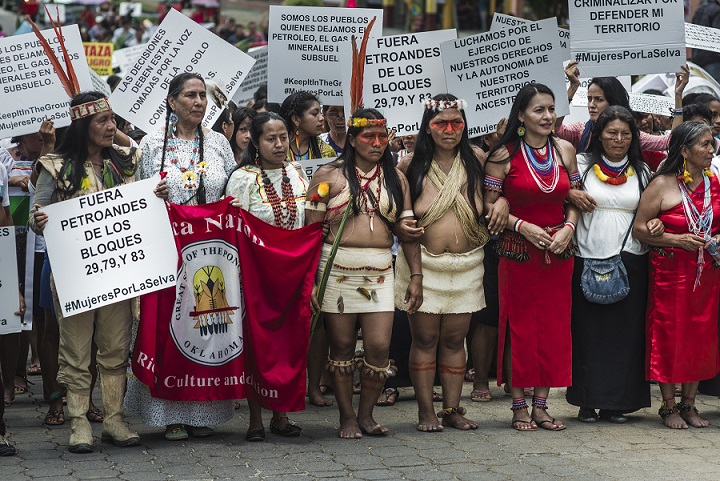
by Deep Green Resistance News Service | Mar 9, 2016 | Indigenous Autonomy, Protests & Symbolic Acts
By WECAN International
SAN FRANCISCO, Calif., March 9, 2016 – In recognition of International Women’s Day, Indigenous Amazonian women leaders of seven nationalities including: Andoa, Achuar, Kichwa, Shuar, Shiwiar, Sapara and Waorani nationalities and their international allies took action in Puyo, Ecuador, in a forum and march in defense of the Amazon, Mother Earth and for climate justice. Specifically, they came together to denounce a newly signed oil contract between the Ecuadorian government and Chinese oil corporation Andes Petroleum.
By plane, foot, canoe, and bus, some five hundred women mobilized from deep in their rainforest territories and nearby provinces marching through the streets of the Amazon jungle town of Puyo.
Chanting, “Defend the forest, don’t sell it!” and carrying signs reading “No more persecution against women defenders of Mother Earth,” the march culminated in a rally in which each nationality denounced the new oil threat and shared traditional songs and ceremonies. The women spoke of other methods for protecting and defending the Amazon and its vital living systems, making it known that the women of the Amazon are not just victims of environmental and cultural genocide, but rather are vital solution bearers.
In addition to highlighting the grave social and ecologic implications of this new contract and the Ecuadorian government’s plans to tender several more oil blocks in the pristine, roadless southern Amazon, the women and allies brought light to their struggles and the ongoing criminalization faced as they stand to protect and defend their territories and lifeways based upon living in harmony with the natural world. A tribute was held in honor of Berta Caceres, the Honduran indigenous environmental leader who was killed last week for her years of work defending rights and territories from privatization, plantations, and most recently, a mega dam project.
The women of the Amazon were also joined by Casey Camp Horinek, WECAN delegation member and Indigenous leader of the Ponca Nation of Oklahoma, who shared her traditional songs and stories of how her people have been impacted by fracking activity.
“Right now the oil company is trying to enter our territory. That is our homeland, this is where we have our chakras (gardens), where we feed our families. We are warriors, and we are not afraid. We will never negotiate,” explained Rosalia Ruiz, a Sapara leader from the community of Torimbo, which is inside the Block 83 oil concession.
“Although we are from three different provinces, we are one territory and one voice,” Alicia Cahuiya, Waorani leader declared.
As the march unfolded, the Ecuadorian government and Andes Petroleum held a meeting in the nearby town of Shell to organize an illegal entry into Sapara territory, knowing that key leaders would not be present. Outraged, a delegation of Sapara delivered a letter to the meeting, underscoring their peoples’ opposition to the oil project and governments tactics to divide the community. They successfully thwarted the government and company plans, and returned to the streets, victorious.
International allies including the Women’s Earth and Climate Action Network, Amazon Watch and Pachamama Alliance shared messages of solidarity and calls for immediate action to keep fossil fuels in the ground in the Amazon.
“On this International Women’s Day we are reaching across borders and standing together as global women for climate justice to denounce oil extraction in the Amazon and call for attention to the struggles and solutions of local women land defenders,” explained Osprey Orielle Lake, Executive Director of the Women’s Earth and Climate Action Network, “We all depend on the flourishing of these precious rainforests, the lungs of the planet. Now is the time to keep the oil in the ground and stand with the women who have been putting their bodies on the line for years to protect the forest, their cultures, and the health and well being of all future generations.”
“Today was a historic day for indigenous Amazonian women! It was the first time that hundreds of women and their allies marched for the Amazon, Mother Earth and Climate Justice. And the power of women was so strong that plans for oil companies entering Sápara territory today were halted. This is is a signal that the collective call to defend rights and territories by keeping fossil fuels in the ground is working,” says Leila Salazar-López, Executive Director of Amazon Watch.
Belen Paez from Pachamama Alliance declared: “It’s a unique and historical moment to have the experience of solidarity and connection between indigenous women and activists from all over the world standing up for the rights of the Amazon rainforest and its people, we have all been waiting for this moment for so long, and that moment is now.”
The March 8 forum, action and press conference will be followed by a March 9 event and report back, ‘Women of Ecuadorian Amazon and International Allies Stand For Protection of the Amazon Rainforest’ to be held on March 9 at 17:00 at the Biblioteca FLASCO, Universidad FLACSO, Quito.
A solidarity action was also held at the Chinese consulate in San Francisco, CA, to denounce the new oil contracts on Sapara and Kichwa territory and support women’s rights in Ecuador and around the world.
-# # #-
About The Women’s Earth & Climate Action Network (WECAN International)
www.wecaninternational.org
@WECAN_INTL
The Women’s Earth and Climate Action Network (WECAN International) is a solutions-based, multi-faceted effort established to engage women worldwide as powerful stakeholders in climate change, climate justice, and sustainability solutions. Recent work includes the International Women’s Earth and Climate Summit, Women’s Climate Declaration, and WECAN Women’s Climate Action Agenda. International climate advocacy is complemented with on-the-ground programs such as the Women’s for Forests and Fossil Fuel/Mining/Mega Dam Resistance, US Women’s Climate Justice Initiative, and Regional Climate Solutions Trainings in the Middle East North Africa region, Latin America, and Democratic Republic of Congo. WECAN International was founded in 2013 as a project of the 501(c)3 Women’s Earth and Climate Caucus (WECC) organization and its partner eraGlobal Alliance.











